Tags
The problem with Bangkok for a first time visitor is that there is just too much to see and do. The city is so overflowing with historical sites, museums, attractions, cultural sites, and exotic experiences it is impossible to take them all in on a single visit. You can stick to the tried and true, those places that always make it to guidebook and internet site Top Ten lists, but that seldom provides you with a full picture of what Bangkok is all about. You can spend weeks in advance of your visit scouring guidebooks and the internet to come up with the places you want to visit and the things you want to do, but your unfamiliarity with Bangkok then results in your spending too much of your limited time crisscrossing a city that has a well deserved reputation for not being easily crisscrossed. And so focused on the next spot on your list, you’ll probably fly right by something more deserving of your time anyway.
With all the activities and sights worthy of a visitor’s time, it’s no wonder that so many travellers get that lost, dazed, confused, and totally worn out look on their faces by the third day of their trip. Bangkok can just be too much if you allow it to be. Forget about needing a vacation from your vacation when you get home, you might not even survive long enough to make it to your plane. As important as seeing everything that you can may seem, a major part of being on holiday is just that. Relaxing, doing nothing, just allowing the ambiance to soak into your consciousness is, in my book, even more important than a 30-minute tour of where some member of the royal family once lived. And my fifth entry to my Top Ten Bangkok experiences is devoted to just that: sitting on your ass. No worries, there’ll be plenty of walking involved too – though strolling is a more appropriate phrase – ‘cuz we wouldn’t want your ass to go completely numb. You may still want to use it later at night
Of course you can’t very well start a day’s outing devoted to sitting on your ass by getting up with the crack of dawn. Even as appropriate as that may sound. Instead, let your hotel empty of your fellow travellers – you’ll see them again much later when they all look like zombies – your day begins at a respectable hour, around 11ish. By now you should have mastered using the BTS, if not consider it a bonus round for today’s experience and head for the National Stadium Station, the terminal point for the Silom Line where the MBK Mall is located. But you won’t be visiting the mall. You won’t be visiting your next way point either. Get used to it. You won’t be visiting a lot of places today.
Use Exit 1 to the street level and walk down Soi Kaem San 2 to Jim Thompson’s House (you can take a tuk tuk instead, the route itself is of little interest). Jim’s place makes it onto everyone’s Bangkok Top 10 List, so we’ll give it the attention it deserves and walk right past the place. You’ll soon hit the San Saeb canal, turn left and cross the bridge to Ban Krua.
The Ban Krua community, made up of Cham Muslims from Cambodia, dates back to the time of Rama 1 when they fought on the side of Siam during the Burmese-Siamese wars and were granted the land just outside of the Old City in recognition for their loyal service to the king. It’s no coincidence that Jim’s place is located just across thee canal; silk weaving was a traditional craft of the Cham and they brought these skills with them to Ban Krua. In the 1940s Jim convinced a group of eight Cham families to produce a sample batch of silks which he took to New York. The silks hit Vogue and the rest is history. And so were most of the Cham.
Jim’s company no longer buys from the Cham, making their own silk in a factory in Korat instead. You, however, can; there are still silk weavers at work in Ban Krua, and they offer some of the best prices on Thai silk in town. Even if you are not interested in purchasing textiles, a stroll though the predominately Muslim community provides a historical glimpse at what is now considered a traditional Thai handicraft. And a much better one than the bus tour throngs will be seeing back at Jim’s house. If you do make a purchase, ask that it be wrapped in a few extra layers of plastic bags, ‘cuz things are about to get wet.
Head back to the canal and the Baan Krua Nua pier – you are about to experience one of the cheapest and quickest ways to get around Bangkok. It may also be one of the wettest. Riding on the Khlong Saeb Saep Ferry can make a tuk tuk ride seem tame. It’s not something many touri do, but the locals know better and about 60,000 of them ride the Saen Saep Express Boats daily. The service has a checkered reputation among touri, due to the polluted water in the khlong and the nature in which the boats operate. But it’s time your ass got a chance to rest – and trust me, for this journey you will want to sit down.
Using the canal boats is easy. As long as you are quick. They tend to take off from a pier just before the last customer is ready to get on. Or off. With luck you will be boarding with some locals, and can just follow their lead. If not, aim for the middle of the boat. There really is no designated entry way – you climb down onto a seat that may or may not be occupied depending on how filled the boat is. Ignore whoever it was you just stepped on and sit down. Quickly. The boat will be taking off soon. Or it already did.
Fares run from 10 to 20 baht, you’ll be going to the end of the western or Golden Mount line – Panfa Leelard – which is only 4 stops away. The fare should be 10 baht, thanks to your farang face it may go as high as 15. Soon after the boat takes off roaring down the water way, one of the ticket collectors will find you. Tell him where you are going, he’ll quote the fare, hand you your change, and issue you a ticket. Or conversely, just pass over a 20 baht note without saying a word and watch to see what you get back as change.
Normally you need to be on your toes riding the canal boats, they only stop at a pier when someone needs to get off there or someone is waiting to board. But since you are going to the last pier, no problemo (though you will still have to get off quickly!) The sights along the route are not much to speak of, though it is an interesting and different view of Bangkok. Watching the guys working on the boat scuttling barefoot along the gunwales – and ducking at the last moment to make it under a bridge in one piece – is a better way of passing your time. In any case, you won’t have much of a view. Once the boat gets underway some local will pull on the plastic tarp curtains running alongside the boat to raise them and keep the dirty water from splashing on passengers.
Safely back on terra firma once again, from the Panfa Leelard pier the first recognizable site you’ll see is the Golden Mount. It too is usually on everyone’s Bangkok Top 10 List, so we’ll give it a pass. Consider it your new tradition. Instead, exit towards Ratchadamnoen Road, walk over the bridge and hang a left on Thanon Mahachai (Wat Ratchanadda is on the far corner of this intersection), walk down about two blocks and just after you pass the gas station stop at the first open-to-the-street restaurant on your left. This is Thip Samai, the best Pad Thai restaurant in Bangkok. And since that’s all they serve, you won’t have to worry about what to order for lunch.
You may have tried Pad Thai elsewhere in Bangkok, it’s one of the city’s best known dishes. If so, what you’ll get at Thip Samai will convince you that you have not tried Pad Thai before. This is Bangkok’s most famous Pad Thai restaurant, and invariably voted as having the best Pad Thai in town. Usually, it is a zoo. By 5pm locals are lining up for dinner and take-away. That’s when the place officially opens. But just after noon, a small portion opens for the lunch crowd and you’ll have a good chance of snagging one of the less than a dozen open tables.
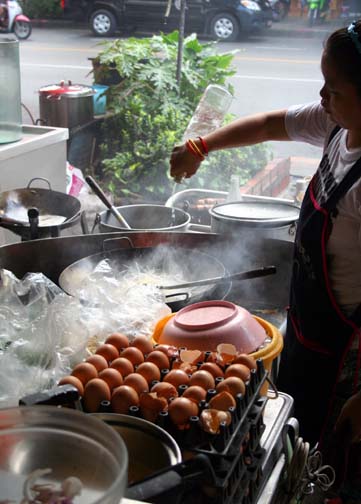
Bangkok’s best Pad Thai may not have the desired effect on your ass that’d you’d hoped. But your tummy will be smiling.
There are three, or maybe it’s four, versions of Pad Thai on offer at Thip Samai, I’d recommend the Pad Thai Haw Kai Goong Sot, which comes wrapped in an egg. It’ll run you 70 baht. And while there are more enjoyable spots with a better ambiance to rest your ass (which we’ll be getting to again soon) none can compare for a truly Thai dining experience.
After lunch, cross the street and head back up toward Wat Ratchanadda. Before the wat, you’ll come across a concrete path way leading alongside Khlong Wat Thepthida, hang a left and stroll alongside the canal for a taste of ‘old Bangkok’. To your right is the back entrance to Wat Ratchanadda, which will take you into its amulet market. The display of religious paraphernalia here is astounding, it’s a popular market for monks from other wats to purchase trinkets for sale at their temple. Meandering along its aisles, you’ll eventually end up at Wat Ratchanadda and the Loha Prasat, which provides a decent interactive visit to one of Bangkok’s more unusual wats. Make sure you climb the staircase of the Loha Prasat for some incredible rooftop views of the Old City.
Ratchadamnoen Road fronts the temple and there are always a handful of tuk tuks and taxis waiting for a fare. If you have not yet experienced being scammed with a multiple temple cum jewelry store tuk tuk ride, these guys will fill that need. Catch one back over on Thanon Mahachai instead, and it’s a 35 baht ride to Khaosan Road.
Khaosan is the backpacker ghetto of Bangkok, the temporary home of the world’s youth who are out to experience the world and instead experience small enclaves of it filled with white faces. Many would argue, and perhaps rightfully so, that Khaosan has little to do with Thailand. But it is, for many, their entire Bangkok experience, and different enough from the rest of the city that you should have a small taste of its scene.
During the day Khaosan is basically a street market. And a poor one at that. It’s also a street cafe scene, rating just as low in that regard. Between the scam artists, aggressive street vendors, and roving packs of scum intent on selling you magic wallets and oversized cigarette lighters, you’ll wonder why the place exists. To discover why the place exists, you’ll need to walk its about four block length to the opposite end, take a right and then an immediate left into Soi Rambuttri.
Soi Rambuttri is a unique U shaped lane that straddles a massive white walled temple compound called Wat Chana Songkhram. It’s what Khaosan was twenty years ago. Walking around can be quite beautiful as large Banyan trees provide cooling shade cover. Like Khaosan, Soi Rambuttri is a haven for backpackers and budget travelers. Unlike its ugly step-sister it’s a place where life slows down in a city that is moving forward at a hectic pace. Among Bangkok’s grit of congested traffic and crowds of shoulder to shoulder pedestrians, Soi Rambuttri is a tiny slice of heaven just north of all the hustle and bustle. It’s a bohemian community filled with street-side cafes, restaurants, and bars. And a perfect place to plop down and sit awhile while you watch a colorful stream of people pass by.

Soi Rambuttri is what Khaosan Road was 20 years ago and a great place to spend hours accomplishing nada.
Soi Rambuttri’s stone-paved path is a vibrant street scene and there are tons of street stalls selling music CDs, used books, second-hand guitars, funky T-shirts, and more. It’s just not as pushy and in your face as Khaosan. And it’s cheaper too. It’s becoming one of my favorite places to hang out in town. Stop in at Book Lover, just before the bend in the street – there is no sign, but the shop has an all-white appearance – for one of the cleaner and more organized used-book shops in the area. Grab some reading material and hit the first cafe that interests you and the rest of your afternoon will be complete.
When dusk begins to set, head off in the direction you were walking several hours ago and take a right on Soi Chana Songkhram. At the end, take a right onto Phra Athit Road. This to is a cafe/pub/bar lined street though it can be a bit more mature and cosmopolitan than Soi Rambuttri. There’s no good reason not to stop, have another beer, and savor Phra Athit Road’s scene. And if it is to your liking and you stay for a bit, Jazz Happens at the Bar Bali Pub and Restaurant is popular among the locals (though farang don’t seem to know about it) offering some of the city’s best live jazz, a collaboration with Silpakorn University’s ‘Faculty of Jazz’ and played by Thai jazz students along with their professor.
Phra Athit Road is also home to Phra Sumen Fort, which is best seen at night when it is lit up. It, along with Mahakhan Fort on Ratchadamnoen Road are the only two remaining of 14 forts built by Rama 1 to protect the borders of the Old City. It’s nestled in the quiet Suan Santichaiprakarn Park, which itself straddles the banks of the Chao Phraya River. It too is a great people watching spot and a favorite hangout for local youths.

Phra Sumen Fort on the banks of the Chao Phraya River is the focal spot of Suan Santichaiprakarn Park.
You may become so enamored with the Phra Athit Road scene that you’ll decide to spend the night enjoying its bars and clubs. If it isn’t too late (before 8pm) when you decide to head back to your hotel, look for the small sign for the express boat pier (uh, that’d be Phra Athit Pier) near the Navalai River Resort, and catch a boat on the Chao Phraya to get back to the central area of Bangkok. It won’t be quite as thrilling as your boat ride in, but the historical buildings lit up at dusk and the balmy breezes blowing across the river make for a pleasant ride. And your ass will thank you – it will be in much better shape than your fellow travellers who spent the day rushing from one site to the next will be.
Related Posts You Might Enjoy:

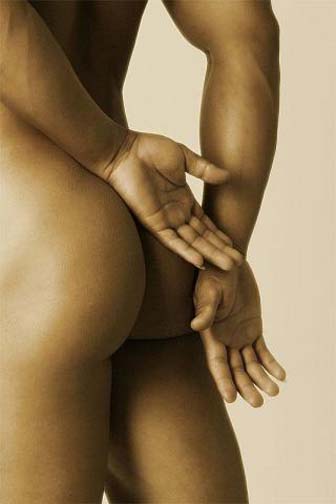
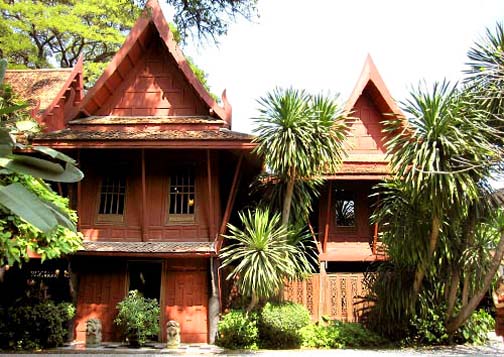

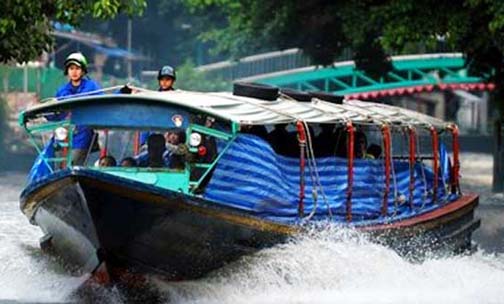
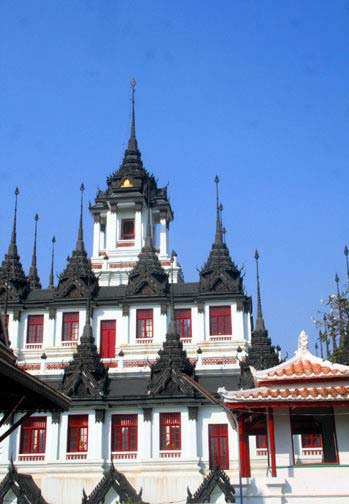

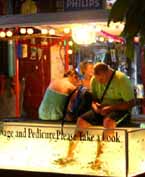
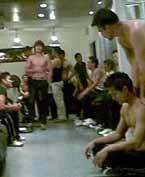
Excellent post. Those little boats are crazy. Getting on and off is definitely a challenge.
Looking forward to seeing Loha Prasat on my next visit
Note Christian’s comment below.
I was surprised to read you had not visited before Glenn, but then thought of all the places in Bangkok that I still haven’t managed to squeeze in yet. Ah well. Do make time to stroll through the back part of the amulet market when you do visit. It is a lot more than what it sounds like.
Thanks. I will be there in early Nov, so hopefully back to normal by then… Stopping by BKK for just a couple of days after Taiwan and Taipei Pride
Nice.
I saw pix from last year and there were tons of hot guys!
Book Lover! Definitely gonna find that place. Can never resist cheap paperbacks.
There are a lot of used book places in the area. This one just doesn’t smell bad as many do. Plus they will buy back any book you buy from them. Just in case you are a quick reader . . .
The Loha Prasat has been covered under scaffolding for some months. I don’t know how long it will last. The same is true for Wat Thammamongkol (Sukhumvit 101), covered in scaffolding.
Huh.
Last year when I droppeed in theey were working on the wat itself, guess the entire compound is gonna be redone.
Do you know if that means it is closed to visitors? Thai construction safety standards are not always what you’d expect!
Still down on Jim Thompson House even though you’ve read how much fun it is to straighten up the neckties for sale?
LOL
Yeah, I should do a post on how to really enjoy a visit to Jim’s place some time!
I don’t know if Loha Prasat (and Wat Thammamongkol) are closed during construction, but the question is moot: there is nothing to see from outside (apart from scaffolding) and from inside you can’t look outside!
I was in the area today and was looking for “Book Lover” in in the wrong place. Then I found it by chance: Soi Rambuttri is longer than Khao San and stretches up to the river and has several bends. “Book Lover” is in that part closer to the river.
Actually I have been there before and bought one book, this time I barely escaped with two books (leaving two behind, I don’t have time to read them!), so this place gets two thumbs up from ChristianPFC.
Christian, I’ve grown to appreciate your thrifty ways, and while I have no intention on adopting them, my eyes have been opened to a different way of life thanks to your posts and comments. However, this time you have gone too far. There is absolutely no justifiable excuse for not buying every even mildly interesting looking book you discover. Especially at a used book store. You really need to work on this!
🙂
It’s not a question of money, I simply don’t have the time to read all the books I buy and I need a place to store them (already two rows and more books lying on top in my bookshelves).
Huh. From your reports it sounds like you could do better by using part of your bed for storing more books.
🙂
Thanks for the post! You inspired both me and my partner to take the suggested itinerary this afternoon. The Saen Saep canal taxi is sooooo convenient. We visited Ratchanattaram Temple (and there was still scaffolding in the center spire), but visitors could still go up the center spiral staircase to the level just below the top. We had never visited Khao San Road and your suggestion of walking along Thanon Rambuttri was excellent. We missed Thip Samai (sadly), Sumen Fort and Praarthit Road: pooped after walking the length of Rambuttri. Thanks again!
Excellent!
After your first time, using the canal boats gets addictive. Glad to hear you gave them a try!
And thanks for the update on the work going on at the temple. Good to know it is still open for visitors.
Now you just have to go back to try the pad thai at Thip Samai . . .
are there also straight boys in thailand that’s for hire? I’ll be there 3rd week this August, would be my first time. Where can i find them?
sorry if i’m asking in the wrong topic.
Asking about straight guys to do is never off topic Marco.
Most bar boys are straight. Thank the gods. They seem to be more concerned about who is the ‘man’ than they are over having sex with another guy. And even then can surprise you. Tawan, and its muscle gods, probably has the highest percentage of straight bar boys. You’ll do well at X-Boys, X-Size, Hot Male, and Dream Boys too. Enjoy your holiday. And be prepared to be booking a return flight within a week of returning home!
thanks for your response.
I’m 26 and like younger boys (not illegal of course) like 19-22. In those places you mentioned you think I can find those kind of boy toys?
I’m top and would love bottom straight young boys. hahaha.. or am i asking too much? i appreciate for being helpful.
Tawan guys are a bit older though I’ve heard they’ve added a few less built younger guys to the stable recently. Most of the other bars will fill your need, Thai guys often look younger than they are so you should do just fine. Finding one to top will be a bit trickier. The manly ones often don’t admit they will bottom so asking a mamasan isn’t of any help. You can ask the guy at the bar before you off him, but be discrete about it (and be direct too, using euphemisms doesn’t work well). A definitive yes, or okay means you’ll have a 75% chance he will. A sure, or I do everything drops your success rate to about 25%.